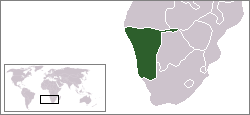South West African Police
| South West African Police Suidwes-Afrikaanse Polisie Südwestafrikanische Polizei | |
|---|---|
| Abbreviation | SWAPOL |
| Agency overview | |
| Formed | 1920 |
| Dissolved | 1990 |
| Superseding agency | Namibian Police Force |
| Legal personality | Governmental: Government agency |
| Jurisdictional structure | |
| National agency | South West Africa |
 | |
| Map of South West African Police's jurisdiction. | |
| Size | 825,615 km² |
| General nature | |
| Operational structure | |
The South West African Police (SWAPOL) were the police force of South West Africa, now Namibia. They existed from 1920 to 1939, and again from 1981 to 1990.
The force was originally established when South Africa assumed the administration of the territory under a League of Nations mandate. The League proved unable to act effectively in the 1930s, and it was disbanded in 1939. The South African Police were responsible for the territory from 1939 to 1981. The SWA Police were re-established in 1981, after the territory had become self-governing. The force was disbanded when the territory became independent as Namibia in 1990. It was succeeded by the Namibian Police Force.
Koevoet
From 1966 to 1989, South African forces battled black guerillas belonging to South West African People's Organisation (SWAPO) in the territory of South West Africa (Namibia), in a conflict known as the South African Border War. In 1978, Minister of Defence Magnus Malan directed the South African Police to establish an intelligence-gathering paramilitary unit similar to the Rhodesian Army's elite Selous Scouts, to fight against SWAPO forces. The SAP established Operation K—popularly known as Koevoet (Afrikaans for "crowbar")—which was quickly dispatched to the battlefront, concentrating on the Caprivi Strip and South West Africa's border with Angola. Koevoet became a component of SWAPOL after it was reestablished in 1981.
Initial Koevoet operations mainly concerned the surveillance of SWAPO fighters, suspected communists, and assorted criminals. However, by 1980, Koevoet became involved in several violent firefights with SWAPO guerillas and raided several SWAPO camps, killing approximately five-hundred rebel operatives. In 1984, search and destroy operations began taking precedence over intelligence gathering, leading Koevoet to become more directly involved in battling SWAPO.
Koevoet was known for its high kill rate, killing approximately three-thousand SWAPO guerillas per year; it became even more infamous for indiscriminately shooting Namibian civilians. In 1985, heavily armed Koevoet officers opened fire on an anti-apartheid protest in the Namibian capital of Windhoek. Eventually, SWAPO compiled a list of numerous atrocities attributed to Koevoet, including torture and assassination, and released it to the foreign press. The South African government bowed to pressure and tried several Koevoet operators of murder. After Namibia's independence from South Africa, Koevoet was disbanded. It is estimated that Koevoet was responsible for up to 80% of Namibian casualties during the Border War.
Sources
- World Police Encyclopedia, ed. by Dilip K. Das & Michael Palmiotto published by Taylor & Francis. 2004,
- World Encyclopedia of Police Forces and Correctional Systems,second edition, Gale., 2006
- Sullivan, Larry E. Encyclopedia of Law Enforcement. Thousand Oaks: Sage Publications, 2005.